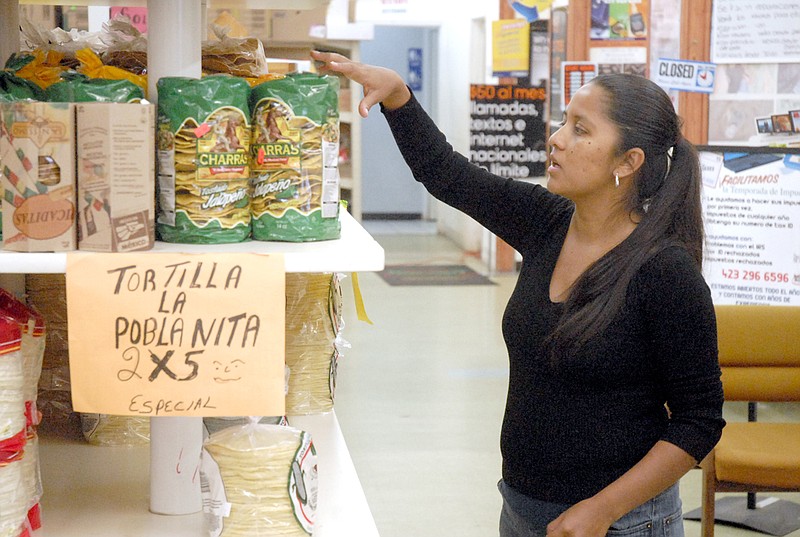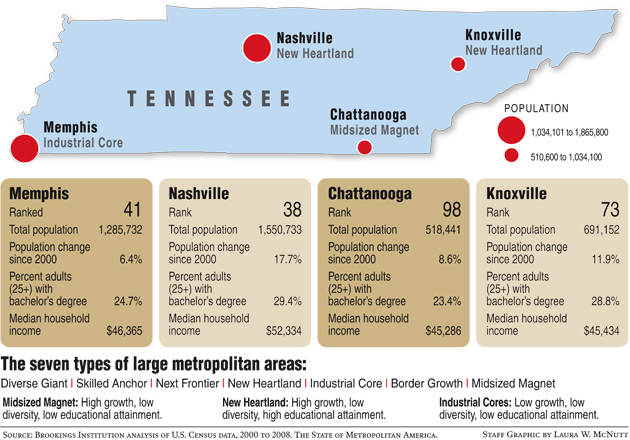Metropolitan Chattanooga is older, less educated and not as diverse as most of America.
But census figures indicate that the Chattanooga area still grew faster than the U.S. average in the past decade, especially within the city of Chattanooga.
In a new analysis of America's major cities, the Brookings Institution lists metro Chattanooga as "a midsized magnet" for its recruitment of new residents and businesses since the dawn of the 21st century. From 2000 to 2008, the six-county Chattanooga area grew 10 percent faster than the U.S. average even though the share of the region's minority population is only about half that of the average for other major metro areas.
"Midsized magnet areas (like Chattanooga) have experienced high growth, while recording a lower proportion of Hispanic and Asian residents, as well as lower educational attainment," said Alan Berube, a senior policy analyst for the Brookings Institution.
Fewer than one in five residents in the six-county Chattanooga metro area identified their race as other than white, according to the most recent American Community Survey compiled by the U.S. Bureau of Census. Nationwide, nearly 35 percent of the U.S. population is now classified as nonwhite.
In metro Chattanooga, minorities also are more than five times as likely to live within the city of Chattanooga as they are to live outside of the city in the rest of the metro area, which includes Hamilton, Marion and Sequatchie counties in Tennessee and Catoosa, Dade and Walker counties in Georgia.
But from 2000 to 2008, the Chattanooga area realized a net migration from Americans relocating to Chattanooga, including many elderly lured to the Scenic City by state and local retirement recruitment programs. In the past decade, the population of the city of Chattanooga grew slightly faster than the suburbs, suggesting that more people are relocating to the city, according to Ochs Metropolitan Studies Director David Eichenthal.
PDF: Metro America report
Like most metro areas in the Southeast, Chattanooga is showing faster growth among Hispanic residents and those born outside of the United States.
"East Tennessee has historically had fewer minorities than most cities in the region, but even though the number is smaller, the growth rate among Latinos is still far greater than for whites," Mr. Eichenthal said.
The number of Hispanic students enrolled in public schools in metro Chattanooga has more than tripled in the past decade from 758 in 2000 to 2,383 in 2008, according to studies by the Ochs Center.
In the 1990s when the city of Chattanooga bounced back from population losses to regaining residents, Hispanic population gains accounted for three fourths of the increase from 1990 to 2000, according to census figures.
"Day to day I can see how the Hispanic community grows in this area," said Sol Rodriguez, English instructor at La Plaza Comunitaria and Chattanooga's State adult education program.
La Plaza Comunitaria is an initiative of Chattanooga State Community College and the Mexican government that lets Hispanic immigrants receive their elementary and middle school diplomas from Mexico.
There are between 160 and 170 students enrolled between La Plaza and the adult education program, she said, not including a long waiting list.
The Loa family has capitalized on that growth since arriving in the region in the mid-1990s and opening seven grocery stores with products geared primarily toward the Hispanic community.
The first store opened in 1996 in Dalton, Ga. - where about 40 percent of the population is Hispanic according to the U.S. census estimates. Almost 10 years later, the family opened the first store in Chattanooga due to an increase in demand, said Jose Luis Loa Jr., owner of three Carnicería Loa stores in Chattanooga and Cleveland, Tenn.
"We were seeing a large flow of clients going to Dalton from Cleveland and Tennessee and that same demand is what pushed us to open the first store in Chattanooga," he said.
He said their sales have remained stable despite the economic slowdown, which indicates to him there's a continuous arrival of Hispanic immigrants to the community.
"It's really hard to estimate the exact number of immigrants because not all of them are our clients and it's a very mobile population, but we have definitely seen a constant increase," he said.
Nationwide, the Brookings study found almost a quarter of the U.S. children have at least one immigrant parent. In Chattanooga, about one of every 12 children born has at least one parent who is foreign born.
Educational attainment of Chattanooga also is showing signs of improvement. But the percent of adults with bachelor's degrees in metro Chattanooga was still the lowest among Tenneseee's major cities and the share of young adults in college in Chattanooga was 15 percent lower than the U.S. average, according to the Brookings analysis.
Continue reading by following these links to related stories:


